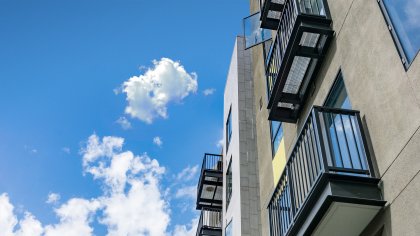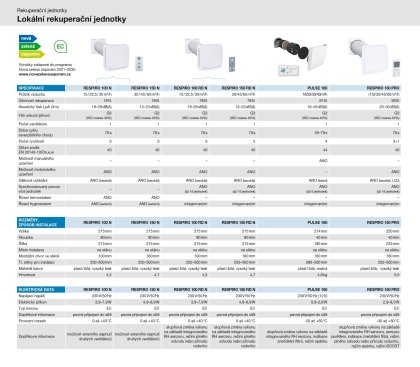Ventilation, at its most basic level, provides air exchange in the interior of buildings. Since people spend most of their time indoors, the quality of the indoor environment has a major impact on their health. The indoor microclimate has a major impact on the incidence of allergies, respiratory diseases and other health problems.
Ventilation, at its most basic level, provides air exchange in the interior of buildings. As people spend most of their time indoors, the quality of the indoor environment has a major impact on their health. The indoor microclimate has a major impact on the incidence of allergies, respiratory diseases and other health problems. It is well known that if buildings are free from excessive humidity and at the same time have an adequate supply of fresh air, the risk of these diseases is generally low.
Compare local heat recovery units in the picture on the right.
Nowadays (depending on the required energy savings and CO2 reduction) the airtightness of new and insulated buildings reaches such parameters that natural ventilation by infiltration is ineffective. Insulating and sealing the external envelope creates a major problem. This is the problem of so-called inadequate ventilation, which is manifested by increased internal humidity, accompanied by mould growth and concentrations of CO2 and a range of harmful toxic substances. This rapidly deteriorates the indoor air quality. Mould proliferation, possible damage to building structures and an environment unsuitable for human habitation are created. Recent research around the world has shown a direct link between human health problems and inadequate ventilation.
Premises occupied by people must be adequately ventilated to ensure a healthy environment. Adequate ventilation cannot be provided naturally today (infiltration of tight windows is close to zero). The solution is so-called controlled ventilation, which removes the polluted air according to the production and concentration of pollutants and ensures the supply of sufficient fresh air. So-called "low-energy" and "passive" buildings, nowadays referred to as near-zero heat buildings, cannot do without forced controlled ventilation.
Window opening, however, cannot be considered controlled ventilation, as this type of ventilation is dependent on the outside climatic conditions. Windows are mainly opened when there is an odour, i.e. only when there is a strong subjective feeling of stale air. Unfortunately, people can adapt very quickly to these sensations (smell, heat) and become inert to them, or cover them up with air fresheners, for example. The biggest problem, in this case, is not the subjective feeling of the person, but the health consequences caused by harmful substances (CO2, VOC - free organic compounds, formaldehyde, etc.) that are not perceived by the sense of smell. Inadequately ventilated spaces are very often contaminated by mould, especially in areas with higher relative humidity. The most commonly occurring moulds cause allergies and are also involved in the development of cancer.
The presence of harmful substances in the interior is usually only recognised after the onset of health problems (fatigue, burning eyes, lack of concentration, poor quality sleep). Allergy-causing substances (pollens, VOCs, etc.) manifest themselves in a short period of time and are therefore easily recognisable, unlike most pollutants, where health problems only become apparent after a very long period of exposure, even 10 to 15 years. This is a long-term exposure to toxic and carcinogenic substances. The sources of these harmful substances are found indoors and are produced in smaller concentrations by building structures, common household furnishings and household products. Among the most dangerous substances that pose a direct threat to health and life is toxic carbon monoxide (CO), which is produced by imperfect combustion (heating, hot water, cooking on a gas stove). The main carcinogens include cigarette smoke, formaldehyde (home furnishings, furniture, building structures, paints, detergents, sealants, adhesives).
Only by sufficient ventilation can these concentrations of harmful substances be effectively reduced below their permissible exposure limits. If we then want to reduce the energy consumption of ventilation, we must use controlled ventilation with heat recovery from the exhaust air. There are currently a number of forced ventilation systems. Their choice is influenced by local legislation, standard requirements and local climatic conditions. Forced ventilation systems are designed to provide the minimum necessary oxygen supply (minimum intensity of air exchange in the space - so-called continuous ventilation) and for more intensive extraction at dangerous pollutant concentrations (impact, time-limited ventilation).
The standard values are focused on the minimum ventilation requirements for the extraction of pollutants (odours, humidity) and the provision of sufficient oxygen supply by outdoor air (min. 25 m3/hr/person). In the Czech Republic, building legislation (Decree No 20/2012) refers to standard values. These can be taken from the still valid standards ČSN 74 7110 - residential cores and ČSN 73 0540 - 2 - thermal protection of buildings.
The detailed requirements for ventilation of flats and apartment buildings, including recommended ventilation systems and the concept of ventilation of flats, are most comprehensively and comprehensively addressed in the standard ČSN EN 15665 - Ventilation of buildings with the values given in the national supplement to this standard - amendment Z1. It is required that the amount of outdoor air exchanged during occupancy is 25 m3/h per person, or that there is a minimum air exchange (0.3 to 0.5).h-1. Carbon dioxide (CO2) is used as an indicator of indoor environmental quality, the concentration of which in the indoor air must not exceed 1500 ppm (which is a considerably softened requirement, the original limit was 1000 ppm). CO2 is designated as an essential pollutant. Although it is not smelled, it contributes to feelings of discomfort, fatigue, lack of concentration and health problems.
Requirements for ventilation of residential buildings according to National Annex Z1 to EN 15665:
Table 1: Continuous ventilation (outdoor flow rate)
| Requirement | Ventilation intensity (h-1) |
Outdoor air dose per person [m3/(h-os)] |
| Minimum value | 0.3 | 15 |
| Recommended value | 0.5 | 25 |
Table 2: Impact ventilation (exhaust air flow rate)
| Requirement | Kitchen [m3/h] |
Bathrooms [m3/h] |
WC [m3/h] |
| Minimum value | 100 | 50 | 25 |
| Recommended value | 150 | 90 | 50 |
How to ensure indoor air quality without excessive energy consumption
Using controlled forced ventilation, in which fans are used as the driving force for air movement. Controlled ventilation with heat recovery is a controlled ventilation system with a heat recovery coil. The heat exchanger, together with the fans, is housed in a compact ventilation unit. This ensures not only a constant supply of fresh air, exhaust of contaminated air, but also savings in heating. The air is preheated by the heat recovery heat exchanger at the cost of the operation of the unit only, not at the cost of heat energy or its production. This ensures a comfortable environment free of dust, noise and pollen allergens with ideal indoor humidity.
Local ventilation units
For rooms where central ducted ventilation units cannot be installed, small local ventilation units with heat recovery have been developed to provide efficient air exchange without the need for conventional window ventilation. The units were originally designed for single room ventilation and are often incorrectly referred to as "room or single room heat recovery" for decentralised ventilation.
These are small, inexpensive heat recovery ventilation units with very simple installation in the perimeter wall of the ventilated room. They use a combination of supply and extract air for controlled ventilation, heat transfer to the air stream via a heat exchanger and efficient filtration. Depending on the type of heat exchanger used for heat recovery, local units can be divided into heat recovery (heat transfer only) and regenerative (heat and moisture transfer).
Recuperative units are equipped with a conventional plate or tube heat exchanger, two fans (for supply and extract air) and filters. These units operate as equal pressure units with simultaneous supply and extract air from the ventilated room. Therefore, they do not operate with switching ventilation cycles like units with a regenerative heat exchanger.
Regenerative units (so-called switching units) are equipped with a ceramic regenerative heat exchanger, a reversible fan (which ensures alternation of supply and extract air depending on temperatures, air flow and direction of air circulation) and air filtration. The principle of regeneration in these units is that when the heated indoor air is exhausted, the heat and moisture is stored in the heat exchanger and when the outdoor air is drawn in, this heat is released and heats the fresh outdoor air. This saves the energy of the heating system considerably. In summer, both types of local units use the heat recovery principle in reverse. They cool the fresh warmer outdoor air to the original room temperature.
Local ventilation units were originally designed to ventilate a single room, but today, thanks to the use of EC motors with continuously variable speed and the development of automatic microprocessor control systems, they are increasingly used for the controlled ventilation of entire apartments and houses. Multiple units and automatic control systems with ventilation cycles (alternating or synchronous) are used for these systems. If one unit brings in air, the other removes it. These decentralised systems are mainly used for reasons of ease of installation, no ductwork and simple maintenance. Recently there has been a rapid development of decentralised systems, especially in Germany and Austria. In 2018, the EU published a study by EwWatt, looking at the energy assessment of decentralised AC systems. The conclusion of the study states that decentralised ventilation achieves high ventilation efficiency with efficiency quite comparable to other systems (e.g. central systems).
Benefits of a decentralised ventilation system:
- It is controlled ventilation with heat recovery
- fresh air without noise, dust and draughts, reduced concentration of viruses in the indoor environment, humidity control
- suitable for radon ventilation
- suitable for new buildings and especially for renovated buildings
- simple installation of the units in the perimeter wall, without piping
- easy maintenance (only filter change) and long service life
- multi-speed wired or wireless control, automatic control of multiple units in cycles
- all-weather functionality
- Heating energy savings (40 to 90% thermal efficiency)
- quiet, draught-free ventilation (noise level between 20 and 40 dB)
- noiselessness (similar sound attenuation value to that of the building structure - external walls)



